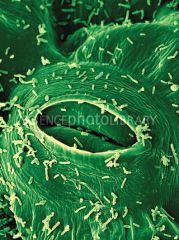![]()
![]()
![]()
Use LEFT and RIGHT arrow keys to navigate between flashcards;
Use UP and DOWN arrow keys to flip the card;
H to show hint;
A reads text to speech;
15 Cards in this Set
- Front
- Back
|
Agrobacterium Established by
|
H. J. Conn
|
|
|
Agrobacterium is
|
A genus of Gram-negative bacteria , non-sporing, motile, rod-shaped bacterium,grow aerobically, without forming endospores and closely related to Rhizobium.
Have one to six peritrichous flagella. Cells are 0.6-1.0 m m by 1.5- 3.0 m m and may exist singly or in pairs. |
|
|
Well known for |
Its ability to transfer DNA between itself and plants, and for this reason it has become an important tool for genetic engineering.
|
|
|
Classification
|
Agrobacterium genus Classification is quite heterogeneous
Recent taxonomic studies have reclassified all of the Agrobacterium species into new genera, such as Ahrensia , Pseudorhodobacter , Ruegeria , and Stappia, most species have been reclassified as Rhizobium species. |
|
|
Most commonly studied species in this genus
|
Agrobacterium tumefaciens
|
|
|
Agrobacterium tumefaciens |
A. tumefaciens is an alphaproteobacterium of the family Rhizobiaceae, which includes the nitrogen-fixing legume symbionts |
|
|
Commonly found in |
Agrobacterium tumefaciens is found commonly on and around root surfaces -the region termed the rhizosphere -where it seems to survive by using nutrients that leak from the root tissues.
|
|
|
Site of Action |
Wound in Plant |
|
|
Host Range and Distribution
|
Agrobacterium tumefaciens is cosmopolitan in distribution, affecting dicotyledonous plants in more than 60 different plant families. Crown gall can be found most often on stone fruit and pome trees as well as brambles and several species of ornamental plants.
|
|
|
Disease caused by Agrobacterium tumefaciens
|
crown gall disease , especially in members ofthe rose family such as apple, pear, peach, cherry, almond, raspberry androses.
|
|
|
Genes involved in crown gall disease
|
Genes are present on a large plasmid, termed the Ti (tumour-inducing)plasmid
|
|
|
Ti plasmid
|
A plasmid is a circle of DNA separate from the chromosome, capable of replicating independently in the cell and of being transferred from one bacterial cell to another by conjugation. Plasmids encode non-essential functions, in the sense that a bacterium can grow normally in culture even if the plasmid is lost
|
|
|
Use in Biotechnology |
to transfer genes to plants and fungi is used in biotechnology, in particular, genetic engineering for plant improvement.
|
|
|
When integrated into the plant genome
|
the genes on the T-DNA codefor:
production of cytokinins production of indoleacetic acid synthesis and release of novel plant metabolites - the opines and agrocinopines. |
|
|
For more information
|

microamaze.blogspot.com
|

